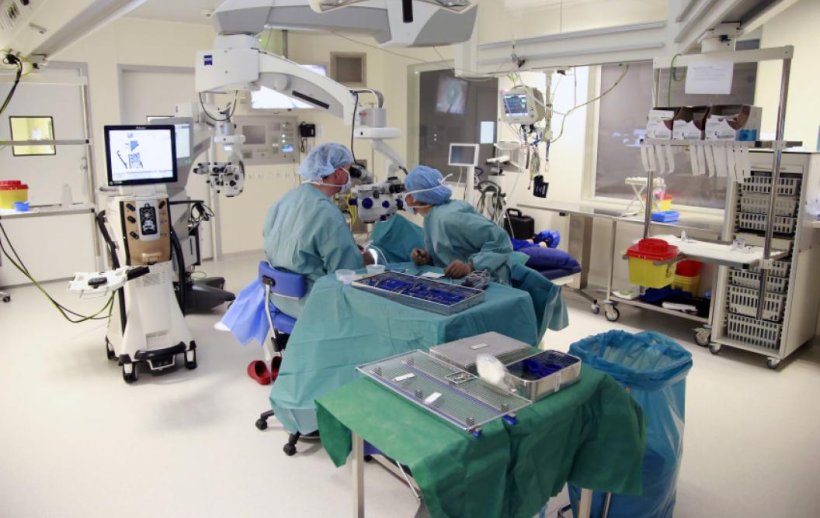
Image source: Maastrict University
News • Equally safe, more cost-effective
Cataract surgery: two-sided treatment better than one-by-one approach
Performing cataract surgery in both eyes on the same day instead of with a two-week interval is equally safe but more cost-effective and patient-friendly.
Patients have to use eye drops for a shorter period and no longer experience the inconvenience of differing vision between their eyes in between. Moreover, a nationwide implementation of this innovation in the Netherlands has the potential to save up to €27 million in societal costs annually, as demonstrated by a large-scale study led by Maastricht UMC+.
After this method was developed and evaluated abroad, Professor of Ophthalmology at Maastricht UMC+, Rudy Nuijts, investigated the bilateral cataract surgery on the same day in the Netherlands. Following a large-scale study funded by ZonMw involving 865 patients, Nuijts and his co-researchers published their results in the scientific journal The Lancet.
Organising the logistics to truly approach the bilateral cataract surgery as two separate procedures is not something that can be done overnight
Lindsay Spekreijse
A cataract is an eye condition in which the lens becomes clouded due to aging, often affecting both eyes. Consequently, vision gradually deteriorates. The traditional treatment involves two separate surgeries to replace the lens with an artificial one, with a two-week interval. These two weeks have traditionally been observed to prevent the occurrence of simultaneous inflammation in both eyes, which is a very rare complication. Additionally, it was believed that during this interim period, the strength of the artificial lens for the second eye could be adjusted if the refractive outcome of the first eye differed from the expected result. After each surgery, the patient receives a specific four-week eye drop regimen, and (telephone) follow-up appointments are scheduled.
This approach has disadvantages: due to the two-week interval, the two eye drop schedules overlap. This can be confusing and complicated for the patient. Some patients receive home care to assist with this. The bilateral cataract surgery on the same day provides a clear and unified eye drop schedule for both eyes. Additionally, the patient is less bound to the process of eye drops and any necessary home care for two weeks. The overall care process is also shortened by two weeks, allowing patients to resume their activities and work earlier.
Using a standardized societal cost analysis, the researchers assessed the potential cost savings that could be achieved by replacing cataract surgeries with a two-week interval with the bilateral cataract surgery on the same day. They considered not only the cost savings in the healthcare process but also factors such as the costs of home care for a portion of the patients and the savings resulting from earlier resumption of work (amounting to approximately €400 per patient). With around 180,000 cataract surgeries performed annually in the Netherlands, the researchers estimated a potential savings of €27.4 million per year.
To minimize the risks of complications in both eyes, the bilateral cataract surgery is approached as two consecutive but separate procedures. After the surgery on the first eye, the surgeon and the surgical team exchange all instruments, medication, and protective gear. Professor Nuijts and his co-researchers observed that this approach does not result in more complications. Additionally, they found that the improvement in vision is just as good as in the unilateral cataract surgery. In other words, the bilateral cataract surgery is equally safe and effective as the unilateral method.
Researcher and ophthalmology trainee Lindsay Spekreijse is delighted, but explains that achieving such significant cost savings takes time. "To achieve the savings we have described, the bilateral cataract surgery needs to be implemented in almost all hospitals and independent clinics in the Netherlands," she says. "However, organising the logistics to truly approach the bilateral cataract surgery as two separate procedures is not something that can be done overnight. Ophthalmologists need to make agreements with the operating room team, the planning department, and the parties responsible for medication delivery and instrument sterilisation. The ten hospitals that participated in this study have already accomplished this, as well as a few other hospitals, known as the 'early adopters.' However, dozens of hospitals and clinics are yet to follow suit. Fortunately, we are receiving more inquiries to share our experiences and help with implementation elsewhere. Additionally, we have received additional funding from ZonMw to accelerate nationwide implementation."
The 865 patients who participated in this study were operated on in ten Dutch hospitals: Amphia Ziekenhuis, Canisius-Wilhelmina Ziekenhuis Nijmegen, Deventer Ziekenhuis, Elisabeth-TweeSteden Ziekenhuis, Gelre ziekenhuizen, Isala, Haaglanden Medisch Centrum, Medisch Spectrum Twente, Zuyderland Medisch Centrum and Maastricht UMC+.
Source: Maastricht University
23.05.2023











